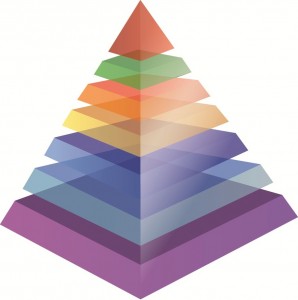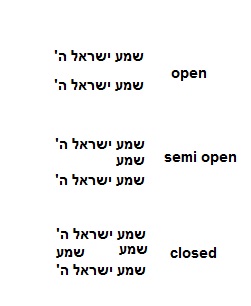Moshe’s Hierarchy of Needs
PDF Printout MishaptimWhen you look at the torah portion this week, Mishpatim, it is difficult, at first glance, to make sense of the way in which it is written. You find dozens of laws that span the entire gamut of Jewish law, scattered with seemingly no logical sequence. A recap of the giving of the Torah is even at the end!
Is there a method to this or do we have no answer to those who would be critical of the way in which it was written?
The Torah most certainly is not poorly edited; rather, it has its own method for expressing things, which is, quite frankly, different than the textbooks and story-line novels we are used to.
One key tool in this case is to look at the different paragraphs with which the Torah is organized[1]. Use the Seven Ways Golden Pyramid image below as a visual reference, from the bottom up. Mishpatim is organized into 6 meta-paragraphs, each with its own theme[2]. They are as follows: (1-Basic Human rights to body and living) (2-civil laws that protect society) (3-‘interpersonal’ laws) (4-laws about maintaining the group) (5- G-ds involvement in entering and settling Israel, and how we should be committed to Him) (6-Theophany at Mt. Sinai, which I will deem 6 &7, as it has uniting of  a nation and coronation of G-d) .
a nation and coronation of G-d) .
Notice how much these levels match up, in general, with the seven sefirot[3] and with the Maslow’s Hierarchy of Needs. The Torah had such a concept of levels of needs since the day it was given! Specific commandments make place to provide a structure of laws and make room for the needs of individuals, groups, and all of Israel. This part of the Torah lays down the laws that are the moral and interpersonal structure of nation of Israel; it is an apropos time as Israel has just left Egypt and needs to be a viable nation both religiously and structurally.
[to bring Rabbi Bailey to give the full, insight-filled Moshe’s Hierarchy of Needs class contact us]
One reason that the Torah may have been written in such a unique way is have us be involved in the generating of meaning from the text. The text is condensed, so we must use the Oral Tradition to extract meaning; it is explicit on one place and cryptic in another; an extra letter are inserted to be a clue at a greater idea, and so on. I’d say the Editor was quite intelligent.
[to learn more about our seven essential needs and how they match up with personality order The Seven Ways]
IB [1] There are three types of paragraphs: open, semi-open, and closed. I made a picture, (not reflective of an actual part of the Torah).
[2] Even within the meta-paragraphs there is a logic to the progression: I think that the order goes from most severe to least. For a full explanation with visual depictions, bring Rabbi Bailey to your venue.
[3] Chesed-life, gevurah-safety, tiferet-balancing human life with boundaried (tiferet it no about creativity on a national level, it’s about borderd, to make along story short.) Netzach/hod-getting the group to have united values, yesod/malchut national unity, preferably in Israel, coronation of G-d as true head of our group.
